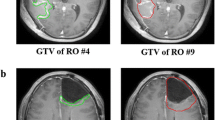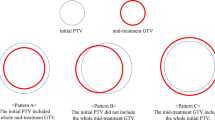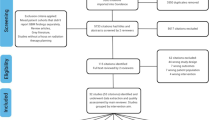Abstract
Purpose
To assess the differences between the target delineation using computed tomography (CT) and imaging fusion CT/magnetic resonance imaging (MRI) for the radiotherapy planning of glioblastoma.
Methods
One hundred-twenty gross tumor volume and clinical target volume on CT and MRI (GTVCT/CTVCT, GTVMRI/CTVMRI, respectively) were contoured and evaluated. The treatments planning (total dose 60 Gy) based on CTVCT were analysed in terms of percentage of CTVCT and CTVMRI receiving 95 % of the prescribed dose (V95-CTVCT, V95-CTVMRI).
Results
GTVs and CTVs contoured on MRI were significantly larger than those delineated on CT (p = 0.0003, p = 0.0006, respectively). Nighty-two percent of CTVCT was coincident with the CTVMRI and 8 % was normal tissue; 20 % of CTVMRI, considered as tumor volume, was not included on CTVCT. The V95-CTVMRI was significantly lower than the V95-CTVCT (p = 0.0005).
Conclusions
In the delineation of glioblastoma target volume, fusion CT/MRI was preferred. The CT only is insufficient for the CTV dose coverage.


Similar content being viewed by others
References
Stupp R, Hegi ME, Mason WP et al (2009) Effects of radiotherapy with concomitant and adjuvant temozolomide versus radiotherapy alone on survival in glioblastoma in a randomised phase III study: 5-year analysis of the EORTC-NCIC trial. Lancet Oncol 10(5):459–466
Balducci M, Chiesa S, Diletto B et al (2012) Low-dose fractionated radiotherapy and concomitant chemotherapy in glioblastoma multiforme with poor prognosis: a feasibility study. Neuro Oncol 14(1):79–86
Balducci M, Apicella G, Manfrida S et al (2010) Single-arm phase II study of conformal radiation therapy and temozolomide plus fractionated stereotactic conformal boost in high grade gliomas. Strahlen Onkol 186(10):558–564
Baumert BG, Brada M, Bernier J et al (2008) EORTC 22972–26991/MRC BR10 trial: fractionated stereotactic boost following conventional radiotherapy of high grade gliomas. Clinical and quality assurance results of the stereotactic boost arm. Radiother Oncol 88:163–172
Balducci M, Fiorentino A, De Bonis P et al (2012) Impact of age and co-morbidities in patients with newly diagnosed glioblastoma: a pooled data analysis of three prospective mono-institutional phase II studies. Med Oncol 29(5):3478–3483. doi:10.1007/s12032-012-0263-3
Chan JL, Lee SW, Fraass BA et al (2002) Survival and failure patterns of high-grade gliomas after three-dimensional conformal radiotherapy. J Clin Oncol 20:1635–1642
Aydin H, Sillenberg I, von Lieven H (2001) Patterns of failure following CT-based 3-D irradiation for malignant glioma. Strahlenther Onkol 177:424–431
Chang EL, Akyurek S, Avalos T et al (2007) Evaluation of peritumoral edema in the delineation of radiotherapy clinical target volumes for glioblastoma. Int J Radiat Oncol Biol Phys 68:144–150
Oppitz U, Maessen D, Zunterer H, Richter S, Flentje M (1999) 3-D recurrence patterns of glioblastomas after CT-planned postoperative irradiation. Radiother Oncol 53:53–57
Hochberg FH, Pruitt A (1980) Assumptions in the radiotherapy of glioblastoma. Neurology 30:907–911
Farace P, Giri MG, Meliadò G et al (2011) Clinical target volume delineation in glioblastomas: pre-operative versus post-operative/pre-radiotherapy MRI. British J Radiol 84:271–278
Weber DC, Wangi H, Albrecht S et al (2008) Open low-field magnetic resonance imaging for target definition, dose calculation and set-up verification during three-dimensional CRT fo glioblastoma multiform. Clin Oncol 20:157–167
Krempien RC, Schubert K, Zierhut D et al (2002) Open low-field magnetic resonance imaging in radiation therapy treatment planning. Int J Radiat Oncol Biol Phys 53:1350–1360
Thornton AF Jr, Sandler HM, Ten Haken RK et al (1992) The clinical utility of magnetic resonance imaging in 3-dimensional treatment planning of brain neoplasms. Int J Radiat Oncol Biol Phys 24:767–775
Just M, Rosler HP, Higer HP et al (1991) MRI-assisted radiation therapy planning of brain tumors clinical experiences in 17 patients. Magn Reson Imaging 9:173–177
Lawrence YR, Li XA, el Naqa I et al (2010) Radiation dose-volume effects in the brain. Int J Radiat Oncol Biol Phys 76(3 Suppl):S20–S27
Halperin EC, Bentel G, Heinz ER, Burger PC (1989) Radiation therapy treatment planning in supratentorial glioblastoma multiforme: an analysis based on post mortem topographic anatomy with CT correlations. Int J Radiat Oncol Biol Phys 17:1347–1350
Minniti G, Amelio D, Amichetti M et al (2010) Patterns of failure and comparison of different target volume delineations in patients with glioblastoma treated with conformal radiotherapy plus concomitant and adjuvant temozolomide. Radiother Oncol 97(3):377–381
Lattanzi JP, Fein DA, McNeeley SW et al (1997) Computed tomography-magnetic resonance image fusion: a clinical evaluation of an innovative approach for improved tumor localization in primary central nervous system lesions. Radiat Oncol Investig 5:195–205
Myrianthopoulos LC, Vijayakumar S, Spelbring DR et al (1992) Quantitation of treatment volumes from CT and MRI in high grade gliomas: implications for radiotherapy. Magn Reson Imaging 10:375–383
Acknowledgments
We gratefully acknowledge Filippo Fiorentino for his support in the revision of this manuscript.
Conflict of interest
None.
Author information
Authors and Affiliations
Corresponding author
Rights and permissions
About this article
Cite this article
Fiorentino, A., Caivano, R., Pedicini, P. et al. Clinical target volume definition for glioblastoma radiotherapy planning: magnetic resonance imaging and computed tomography. Clin Transl Oncol 15, 754–758 (2013). https://doi.org/10.1007/s12094-012-0992-y
Received:
Accepted:
Published:
Issue Date:
DOI: https://doi.org/10.1007/s12094-012-0992-y




